LOGOS and Montreal counter-culture
PK: Later when we got to our last issue, it was 25 000, but it started out as 5000 or something.
But right away with the first issue of Logos, we were all arrested by the Montreal police. First of all, they accused the paper of not being very Catholic, and at first I thought that he was talking about the more universal use of the word, so I was a little upset that it wasn’t deemed Catholic. Then I realized he was talking about the actual religion, and I said: “Oh my God! No. It isn’t! As a matter of fact, it was very anti-Catholic,” and he said: “Uh huh, well, now we’re going to have to charge you!”
So it was an on-going battle between ourselves and the Montreal police, and they were certainly egged on and directed by Mayor Drapeau. They would claim that we had no license to sell the paper on the street, which we didn’t! And we would claim that you couldn’t get a license to sell a newspaper on the street, because it would be a restriction of freedom of the press. This is because if there was a license needed to sell a newspaper on the street, it meant you would have to go through a process, and at the end of the process, you could be denied the license, which would be, again, a restriction of the freedom of the press. We actually staged these photo-opportunities… just go down to city hall and try to buy a license to sell the paper, and we would end up, of course, not getting a license because there was no such thing. But in the end, we must have had over a 150 charges against various people, a lot of them being draft-dodgers and if they were found guilty of the so-called massive criminal offence, they would be sent back to the U.S., but it didn’t stop them from selling the paper on the street.
It wasn’t the people, cause there was a whole range of people selling it. At some point, even playwright David Fennario, mostly known for his later play Balconville, was dropping by to sell the paper.
AK: It was mostly young people, obviously. It was one way they could make some extra cash.
LR: It started out bilingual but didn’t stay so for long, why was that?
PK: It was an interesting time in Montreal and Canada. We were invited to the first Cultural Congress in Havana, Cuba. At the time, we had a number of Quebecois with us, and a person who was instrumental at this point in the development of the Quebec-side of Logos was Jacques Leroux-Langlois. He went to the Cultural Congress on behalf of Logos. I believe it was in the second issue that we printed a supplement on the Cultural Congress, and it was very inspirational, the whole congress was, but also the material that Jacques brought back.
Another little incident was that when the police raided our establishment–which they did many times!–we had a package of information that was given to us for this congress saying “with the compliments of the Cuban embassy in Montreal”. So we cut out that piece of cardboard and taped it to our bright red IBM Selectric typewriter, and the press reported a year later you know, that we had got a gift of a communist typewriter from Havana! (laughs)
Anyways, the next issue, we embraced Quebec Independence, completely, and we had articles from Gagnon & Vallieres, they were the FLQ folks in jail at the time, charged with terrorism and other charges, but were still in communication with their people in Montreal; we published some of their articles. And then it became apparent to us that–as a bilingual paper–we were upholding the same structure that Canada was. So we made a big issue, separating, declaring independence for a French-speaking newspaper called “Le Voyage” (advertised in Logos #5). A number of individuals who were part of the Logos family at the time moved out and published that while we maintained an English, separate entity.
Once we separated, we still had communication, but we did not line up our editorial policies or what we were going to be writing about. I think that a number of individuals stayed in touch, and they were very helpful with a lot of our trials as time progressed.
AT: Do you have an edition of Logos among those on the table here that you’re particularly proud of, or that has more meaning to you?
PK: Well, (pointing at issues of Logos) I got busted for that one, busted for that other one right there…
AT: What was offensive about that?
PK: There’s a picture of a woman in a bathtub in it… they didn’t need any reason, really!
LR: And then there’s this one …
AK: I was asked to pose for the cover in which my body was painted–it wasn’t photoshopped! That wasn’t doable in those days (laughs). I was physically painted and posed holding my hand in front of my face like so, pretending to kiss whatever was sitting in my palm, which was later superimposed as a policeman trying to pull out his gun. Immediately after it came out it was banned, banned obscene! This could not be distributed on the streets of Montreal even though Playboy was very popular and doing good business. But a woman making fun of a Montreal policeman was too much of a political statement, so it was outlawed. So this copy really went underground, not that many copies went out. I was still a student at Beaux Arts, and Paul was charged with publishing obscene material. One of the main reasons we left was because it got so that Paul was not able to do any more publishing in the province of Quebec, because that was a civil suit as opposed to the sedition charges (from the Drapeau issue), which were criminal and federal.
PK: Also, like I mentioned, from the very beginning, every one of these we were busted for selling a paper without a permit! I mean, the very first issue, myself & Chandra got arrested together, it just kept snowballing and we told people: “Keep moving! Don’t stop. Sell a paper and move on!”
LR: How fast did it take off?
PK: It took off pretty quick. The first issue, that attracted the likes of McLaren, the whole crowd around the NFB, and some of the people associated around Take One.
AT: Was the readership just that college, university audience or did you have 16-17 year-olds thinking that it was pretty cool?
AK: I think there were a lot of people from the suburbs that picked it up, and a lot of young kids came downtown and would sell the paper. There was a big street movement going on at that time.
PK: There’s one issue here, there was a guy who was sort of… he was a pharmacist, he ran his family pharmacy in Nova Scotia named Lloyd Stone. He was probably in his forties and of course, we were all very young, early 20s. Somehow he came to Montreal and he found out about the paper and said: “I’m gonna buy an ad in every issue and you can do whatever you want for it.” At one point he bought a back page.
LR: OK before we get to the most infamous Logos issue, you mentioned at the conference on counter-culture an anecdote about another sort of newspaper prank.
PK: The conference was the first time that I’d been to McGill since 1966. At that time there was a particularly interesting writer by the name of Paul Krassner, who published a periodical called The Realist. In our late summer of ’66, he published an article, which was what one would call extreme satire. You would have to be excessively paranoid to believe a word of it– without getting into too much detail, it was a story about Lyndon Johnson masturbating in Kennedy’s wounds on the plane back from Dallas to Washington. And so, the very brave and courageous editor of The McGill Daily decided to publish that article, and within three days, he was fired as the regents of McGill believed the article! (laughs) Which was a statement in itself!
So a bunch of us were very upset about the infringement of the freedom of the press, so we organized demonstrations and rallies. There weren’t too many of us, about 150 of us. At some point, we occupied the administration building and police arrived threatening to charge us with all kinds of things. So then, a number of people left until about 20 or 25 of us were hanging in there. And this way, when we decided to escalate the sit-in and went upstairs and occupied the president’s room. Not only that, we actually started rifling through the president’s files and discovered a lot of incriminating evidence of McGill University’s involvement in armament research, research related to the Vietnam War, and we had actual black and white evidence of this.
LR: This sounds like what may have ended up in that student handbook we talked about earlier. The McGill Daily incident certainly prefigures what happened with the infamous Logos issue.
PK: Our concept of what we were doing in terms of a newspaper was that were creating a piece of guerrilla theatre. Now guerrilla theatre at the time was part and parcel of the sort of anti-war movement, but it also evolved into freedom of assembly and basically–in the United States–freedom of thought! So, the newspaper evolved with that.
One afternoon we gathered at a coffeehouse on Park Avenue, four or five of us, somebody had just come from Boston and had seen a newspaper headline of The Boston Globe that said: “Yanks shot by dope-crazed Cong!” That was actually the headline, and I was so flabbergasted by that, the unbelievable amount of exaggeration and inflammatory statements. Of course, it always was the case that major newspapers in those days spent a tremendous amount of time thinking up headlines like that, and using them to flog their newspaper. So, that was the birth of the idea of a fake issue of The Gazette, and we decided to have our headline be: “Mayor shot by doped-crazed hippie!” So, it was basically a piece of pirate theatre, pirate journalism.
Adrianna and I spent hours in the library at the Gazette itself, and this whole front page was based on the one from when Kennedy was shot. We inserted our own stories but the tone and the structure of the front page was identical to that front-page.
AK: I think we turned the “G” around in The Gazette so that we wouldn’t get caught! (laughs) And the fonts…
PK: Everything was exactly right… but this one article … (pointing to a specific article)
AK: … Was a reject from Midnight.
PK: It was too preposterous! When you go into these things, there is a certain amount of naiveté, and you dream of having such an impact when you’re doing something like this, but you never believe that it’s going to have that impact. We got quite organized over this, and once the newspaper was printed and folded in half, if you looked at it from 3 or 4 feet away, it did look like an issue of The Gazette.
We designed it all, wrote it all, which we did with every paper, but we stayed pretty tight-lipped about this one, because we anticipated there could be a pretty extreme reaction. And we had already been in jail so many times and charged with so many so-called offenses, that we knew we were going to get slammed. We created a strategy to make as much noise as we could. We realized that the best way to do this was to bundle these papers and create a piece of street theatre with them.
Peter Katadotis– who eventually went on to run the NFB in Canada– volunteered to drive us around. The fun part of this whole thing is that he was not part of the sort of Logos inner core at the time, but he heard about it and he got so excited about it! Her & I got into a car with Peter and stacks of our paper– and they were all labelled for metro stations and also for CBC and various radio stations and, theatrically, we would grab the bundle for say Berri and start running into the metro station, screaming at the top of our lungs: “Mayor shot! Mayor shot! Mayor shot!” dump the papers on the newsstand and run away.
At the trial, which was a year later, I was over-impressed with the reaction. What happened was that we dropped some at the old CBC building on Dorchester (now René-Levesque), and we didn’t know this at the time, but they interrupted broadcasting nationally, brought in some experts and started talking about this horrific event, that the mayor had been shot by a doped-crazed hippie. Now, it would have been super easy… if you open that page, you would have known immediately that it was Logos, because the rest of the newspaper was a visual, artistic display of pretty insane graphics. So, there was no doubt that it was a Logos paper and that it was a Logos spoof, but again, I can refer you to The War of The Worlds that Orson Welles did back in the ’30s. There’s no doubt that there’s a huge amount of naiveté and panic to push the button in these situations… I mean, fast-forward: we have Bill C-51, which is a panic-button push.
One of our points, beyond the local Montreal issue of selling a paper without a license, was that newspapers are basically headline-driven. The content is held hostage to the headline, and it’s often false, or certainly exaggerated. That’s why we put out that explosive headline.
Of course, then what happened was during all the distribution and aftermath of it all, they were so embarrassed. Their egos: the police, the mayor, they were all just completely discombobulated and completely distraught over the fact that we pulled this off. So they immediately issued an all-points bulletin, where they sent squad cars everywhere, all over the city, and police officers armed with guns to grab any Logos person at all and to raid the Logos House.
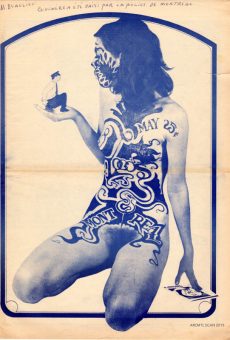
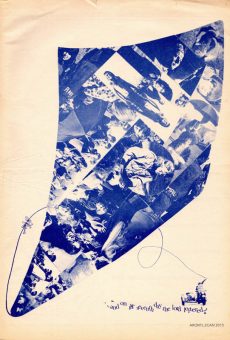
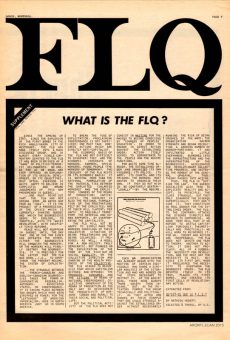
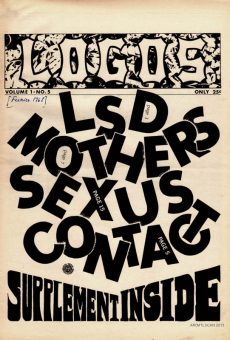
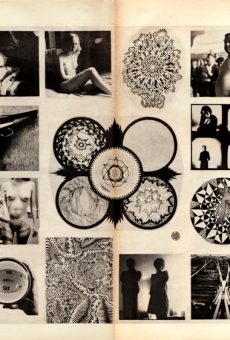
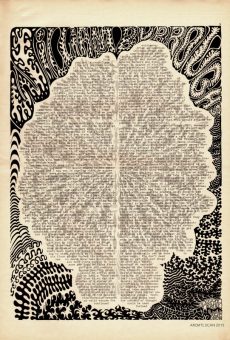
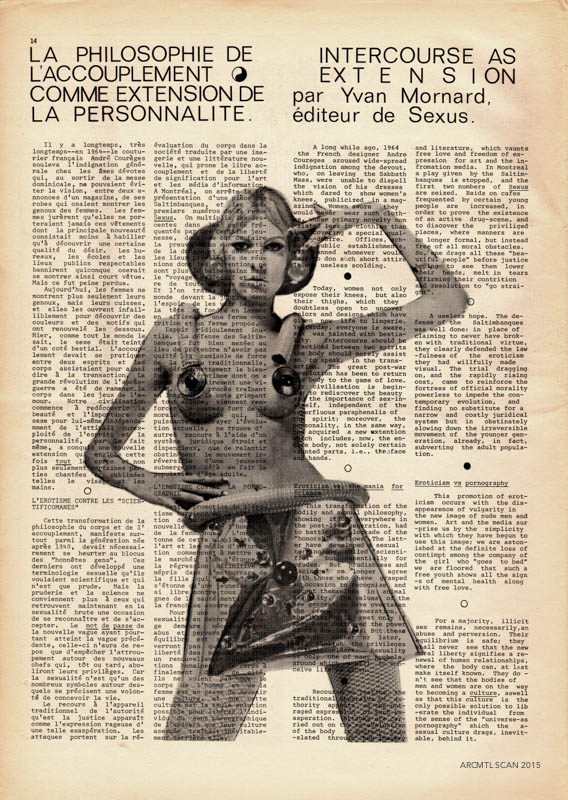
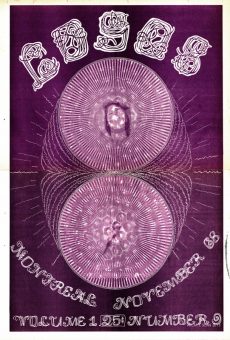
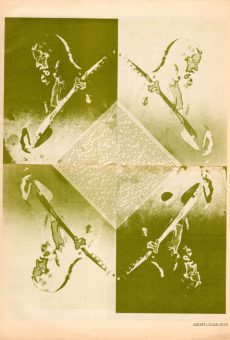
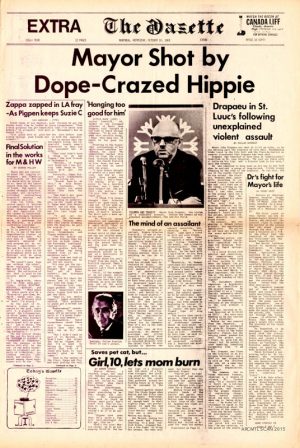
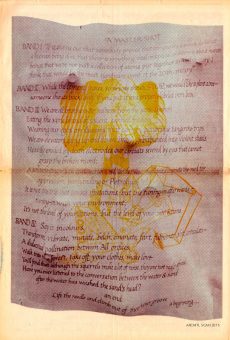


Thanks for this interview!
I´m from Finland and used to be part of the Finnish underground movement late 60s. Believe it or not I happen to have Logos vol 1, no 10 and vol 2, nos 1-4. I don´t need them anymore. Are you still interested to have Logos issues?
Great web site!